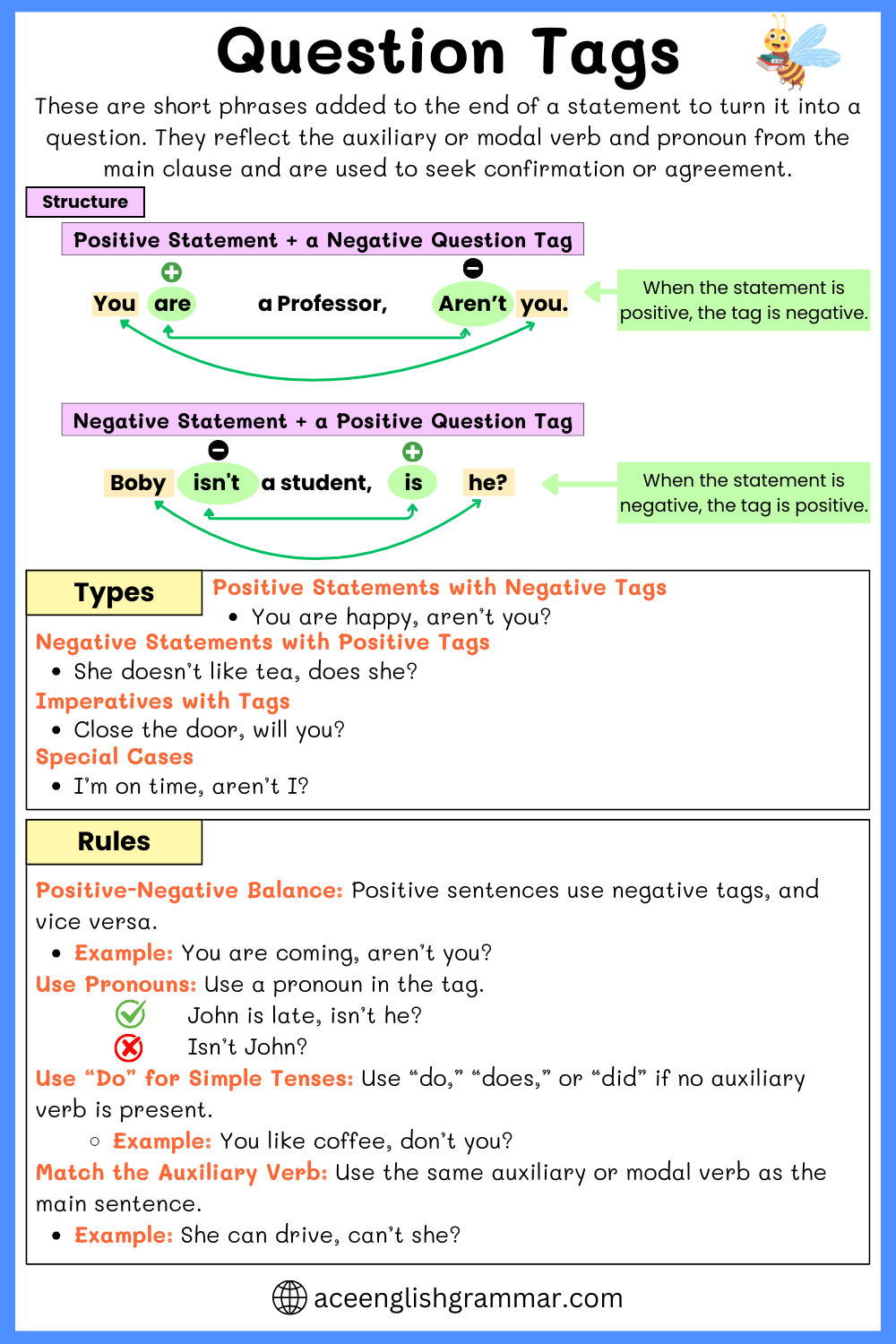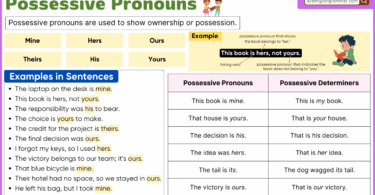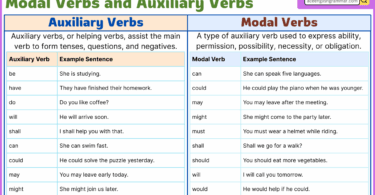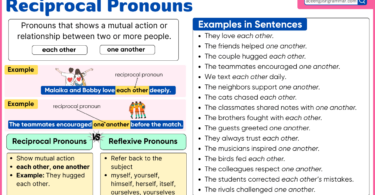Question tags are a simple yet powerful way to make conversations more engaging and natural in English. They are short phrases added at the end of a sentence to confirm information or seek agreement, such as “You’re coming, aren’t you?” Understanding how to use question tags correctly can improve both spoken and written communication. With the right practice, you can use them confidently and sound more fluent in English.
Table of Contents
What Are Question Tags?
In professional grammatical terms, question tags are a type of interrogative structure that transforms a declarative sentence into a question. Usually, a question tag echoes the auxiliary verb from the main statement and adjusts to the subject in number (singular or plural) and tense (past, present, or future).
Simply put, question tags are used to ask for confirmation or agreement.
For instance:
- You’re coming to the party, aren’t you?
- She can swim well, can’t she?
Here, the phrase at the end (aren’t you, can’t she) is the question tag. It matches the auxiliary verb (in this case, are and can) and refers to the subject of the statement.
How to Form Question Tags
There are a few essential rules to remember when forming question tags:
Match the Auxiliary Verb: The tag must use the same auxiliary or modal verb as the main sentence.
- She is happy, isn’t she?
- They were late, weren’t they?
Positive and Negative Balance: A positive sentence gets a negative tag, and a negative sentence gets a positive tag.
- He will join us, won’t he? (Positive sentence + negative tag)
- You didn’t see her, did you? (Negative sentence + positive tag)
Use the Pronoun: Always use a pronoun in the question tag, even if the subject is a proper noun.
- John is a doctor, isn’t he? (Not “isn’t John?”)
No Auxiliary Verb? Use “Do”: If the main sentence has no auxiliary verb (i.e., it’s in the present simple or past simple tense), the verb “do” or “did” is used in the tag.
- You like coffee, don’t you?
- She went home early, didn’t she?
Formation of Questions Tags for Different Structures
Positive Sentences with Negative Tags
| Sentence Type | Example Sentence | Question Tag |
|---|---|---|
| Present Simple | You play football, | don’t you? |
| Present Continuous | He is reading, | isn’t he? |
| Past Simple | They visited Paris, | didn’t they? |
| Past Continuous | She was cooking, | wasn’t she? |
| Future Simple | We will arrive soon, | won’t we? |
| Present Perfect | You have finished, | haven’t you? |
| Past Perfect | He had left already, | hadn’t he? |
| Future Perfect | She will have arrived by 5, | won’t she? |
| Present Perfect Continuous | They have been working, | haven’t they? |
| Past Perfect Continuous | She had been cooking, | hadn’t she? |
| Future Continuous | I will be leaving soon, | won’t I? |
| Future Perfect Continuous | We will have been running, | won’t we? |
| Present Simple with Modal (Can) | She can swim, | can’t she? |
| Present Simple with Modal (Should) | They should come, | shouldn’t they? |
| Present Simple with Modal (Must) | You must go now, | mustn’t you? |
| Future with Modal (Could) | We could try it later, | couldn’t we? |
| Present Simple with Modal (May) | He may come tonight, | mayn’t he? |
| Future with Modal (Might) | She might win, | mightn’t she? |
Negative Sentences with Positive Tags
| Sentence Type | Example Sentence | Question Tag |
|---|---|---|
| Present Simple | You don’t play football, | do you? |
| Present Continuous | He isn’t reading, | is he? |
| Past Simple | They didn’t visit Paris, | did they? |
| Past Continuous | She wasn’t cooking, | was she? |
| Future Simple | We won’t arrive soon, | will we? |
| Present Perfect | You haven’t finished, | have you? |
| Past Perfect | He hadn’t left yet, | had he? |
| Future Perfect | She won’t have arrived by 5, | will she? |
| Present Perfect Continuous | They haven’t been working, | have they? |
| Past Perfect Continuous | She hadn’t been cooking, | had she? |
| Future Continuous | I won’t be leaving soon, | will I? |
| Future Perfect Continuous | We won’t have been running, | will we? |
| Present Simple with Modal (Can) | She can’t swim, | can she? |
| Present Simple with Modal (Should) | They shouldn’t come, | should they? |
| Present Simple with Modal (Must) | You mustn’t go now, | must you? |
| Future with Modal (Could) | We couldn’t try it later, | could we? |
| Present Simple with Modal (May) | He mayn’t come tonight, | may he? |
| Future with Modal (Might) | She mightn’t win, | might she? |
These tables now cover all the tenses and modal verbs with both positive and negative tags. This gives you a comprehensive view of how question tags are formed across different grammatical structures.
Exceptions in Question Tags
Even though most sentences follow the rules above, there are some important exceptions and special cases to be aware of:
With “I am”: When the subject of the sentence is “I” and the auxiliary verb is “am,” the question tag becomes aren’t I instead of the expected am I not.
- I’m early, aren’t I?
Imperatives: When using imperatives (commands), you can add a tag for politeness or encouragement. The tag for commands is usually won’t you or will you.
- Pass me the salt, won’t you?
- Open the window, will you?
Let’s: When the main sentence starts with “let’s,” the tag is generally shall we.
- Let’s go for a walk, shall we?
Negative adverbs: Sentences that contain negative adverbs (like never, hardly, scarcely) are treated as negative, so the question tag must be positive.
- She never calls, does she?
The Purpose of Question Tags
The main reason we use question tags is to either confirm information or seek agreement in a conversation. Here are the two common purposes explained further:
- Confirmation: When you’re fairly certain of something and want to confirm it, you use a question tag. It encourages the listener to agree with what you’re saying.
- It’s cold today, isn’t it? (You believe it’s cold but are asking for confirmation.)
- Encouraging Engagement: Question tags are also used to keep a conversation going or to involve someone in the discussion.
- You’ve met Sarah, haven’t you? (Inviting the listener to engage or share more details.)
Intonation in Question Tags
The meaning of a question tag can change slightly depending on the speaker’s intonation (the rise or fall of voice pitch). There are two types:
Rising Intonation: If your voice rises at the end of the question tag, you are genuinely asking for information or confirmation.
- She’s a great singer, isn’t she? (Rising intonation = seeking confirmation)
Falling Intonation: If your voice falls at the end of the tag, you’re not really asking a question—you’re just assuming the answer is “yes.”
- You’re coming to the meeting, aren’t you? (Falling intonation = expecting agreement)
Common Mistakes to Avoid
When using question tags, learners often make a few common mistakes. Here are some to watch out for:
Incorrect Pronoun Usage: Always ensure the question tag uses a pronoun that matches the subject of the sentence.
❌ Jane is your friend, isn’t Jane?
✅ Jane is your friend, isn’t she?
Wrong Auxiliary Verb: The auxiliary verb in the question tag must match the verb in the main sentence.
❌ He can swim, isn’t he?
✅ He can swim, can’t he?
Using the Same Polarity: Positive sentences get negative tags, and negative sentences get positive tags. Avoid using two positives or two negatives.
❌ You like it, do you?
✅ You like it, don’t you?
Conclusion
Mastering question tags may seem tricky, but once you understand the rules, they become a natural part of English conversation. Remember the core principle: question tags are used to confirm or seek agreement, and they must always reflect the verb and subject of the main sentence. By practicing the rules outlined here, you’ll be able to use question tags accurately and effectively.
Read More




